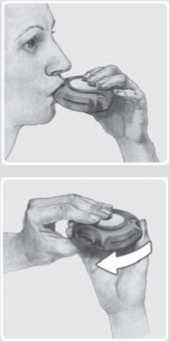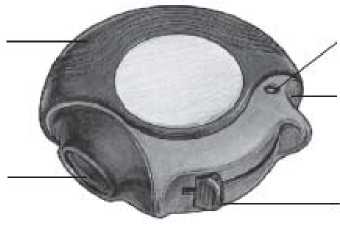Seretide 100 Accuhaler
Out of date information, search another1. What Seretide is and what it is used for



PACKAGE LEAFLET : INFORMATION FOR THE USER SERETIDE® 100 ACCUHALER®
(salmeterol xinafoate / fluticasone propionate)
Your medicine is available as the above name but will be referred to as Seretide throughout this leaflet.
This product is available in multiple strengths and all strengths will be referred to throughout this leaflet
Outer Case
Mouthpiece

Lever
Counter Full Empty
(60 (0
Thumbgrip
Read all of this leaflet carefully before you start taking this medicine.
- Keep this leaflet. You may need to read it again.
- If you have any further questions, ask your doctor or pharmacist.
- This medicine has been prescribed for you. Do not pass it on to others. It may harm them, even if their symptoms are the same as yours.
- If any of the side effects gets serious, or if you notice any side effects not listed in this leaflet, please tell your doctor or pharmacist.
In this leaflet:
1. What Seretide is and what it is used for
2. Before you use Seretide
3. How to use Seretide
4. Possible side effects
5. How to store Seretide
6. Further information
Seretide contains two medicines, salmeterol and fluticasone propionate:
• Salmeterol is a long-acting bronchodilator. Bronchodilators help the airways in the lungs to stay open. This makes it easier for air to get in and out. The effects last for at least 12 hours.
• Fluticasone propionate is a corticosteroid which reduces swelling and irritation in the lungs.
The doctor has prescribed this medicine to help prevent breathing problems such as:
• Asthma
• Chronic Obstructive Pulmonary Disease (COPD). Seretide Accuhaler, at a dose of 50/500 micrograms, reduces the number of flare ups of COPD symptoms.
You must use Seretide every day as directed by your doctor. This will make sure that it works properly in controlling your asthma or COPD.
Seretide helps to stop breathlessness and wheeziness coming on. It does not work once you are breathless or wheezy. If that happens you need to use a fast acting ‘reliever' medication, such as salbutamol.
2. Before you use Seretide
Do not take Seretide if:
You are allergic (hypersensitive) to salmeterol xinafoate, fluticasone propionate or to the other ingredient lactose monohydrate.
Take special care with Seretide
Your doctor will supervise your treatment more closely if you have medical conditions such as:
• Heart disease, including an irregular or fast heartbeat
• Overactive thyroid gland
• High blood pressure
• Diabetes mellitus (Seretide may increase your blood sugar)
• Low potassium in your blood
• Tuberculosis (TB) now or in the past
If you have ever had any of these conditions, tell your doctor before you use Seretide.
Taking other medicines
Please tell your doctor or pharmacist if you are taking or have recently taken any other medicines. This includes medicines for asthma or any medicines obtained without a prescription. This is because Seretide may not be suitable to be taken with some other medicines.
Tell your doctor if you are taking the following medicines, before starting to use Seretide:
• Beta-blockers (such as atenolol, propranolol, sotalol). Beta-blockers are mostly used for high blood pressure or other heart conditions.
• Antiviral and antifungal medicines (such as ritonavir, ketoconazole and itraconazole). Some of these medicines may increase the amount of fluticasone propionate or salmeterol in your body. This can increase your risk of experiencing side effects with Seretide, including irregular heartbeats, or may make side effects worse.
• Corticosteroids (by mouth or by injection). If you have had these medicines recently, this might increase the risk of this medicine affecting your adrenal gland.
Pregnancy and breast-feeding
If you are pregnant, planning to get pregnant, or breast feeding, talk to your doctor before taking Seretide. Your doctor will assess whether you can take Seretide during this time.
Driving and using machines
Seretide is not likely to affect your ability to drive or use machines.
Important information about some of the ingredients of Seretide
Seretide Accuhaler contains up to 12.5 milligrams of lactose in each dose. The amount of lactose in this medicine does not normally cause problems in people who are lactose intolerant.
3. How to use Seretide
• Use your Seretide every day, until your doctor advises you to stop.
• Always use Seretide exactly as your doctor has told you. Don't exceed the recommended dose. Check with your doctor or pharmacist if you're not sure.
For asthma
Adults and adolescents aged 12 years and over
• Seretide 100 Accuhaler - One inhalation twice a day
• Seretide 250 Accuhaler - One inhalation twice a day
• Seretide 500 Accuhaler - One inhalation twice a day
Children 4 to 12 years of age
• Seretide 100 Accuhaler - One inhalation twice a day
• Seretide is not recommended for use in children below 4 years of age.
For adults with Chronic Obstructive Pulmonary Disease (COPD)
• Seretide 500 Accuhaler - One inhalation twice a day
Your symptoms may become well controlled using Seretide twice a day. If so, your doctor may decide to reduce your dose to once a day. The dose may change to:
• once at night - if you have night-time symptoms
• once in the morning - if you have daytime symptoms.
It is very important to follow your doctor's instructions on how many inhalations to take and how often to take your medicine.
If you are using Seretide for asthma, your doctor will want to regularly check your symptoms.
If your asthma or breathing gets worse tell your doctor straight away. You may find that you feel more wheezy, your chest feels tight more often or you may need to use more of your fast acting 'reliever' medicine. If any of these happen, you should continue to take Seretide but do not increase the number of puffs you take. Your chest condition may be getting worse and you could become seriously ill. See your doctor as you may need additional treatment.
Instructions for use
• Your doctor, nurse or pharmacist should show you how to use your inhaler. They should check how you use it from time to time. Not using the Seretide Accuhaler properly or as prescribed may mean that it will not help your asthma or COPD as it should.
• The Accuhaler device holds blisters containing Seretide as a powder.
• There is a counter on top of the Accuhaler which tells you how many doses are left. It counts down to 0. The numbers 5 to 0 will appear in red to warn you when there are only a few doses left. Once the counter shows 0, your inhaler is empty.
Using your inhaler
1. To open your Accuhaler, hold the outer case in one hand and put the thumb of your other hand on the thumbgrip. Push your thumb away from you as far as it will go. You will hear a click. This will open a small hole in the mouthpiece.
2. Hold your Accuhaler with the mouthpiece towards you. You can hold it in either your right or left hand. Slide the lever away from you as far as it will go. You will hear a click. This places a dose of your medicine in the mouthpiece.
Every time the lever is pulled back a blister is opened inside and the powder made ready for you to inhale. Do not play with the lever as this opens the blisters and wastes medicine.
3. Hold the Accuhaler away from your mouth, breathe out as far as is comfortable. Do not breathe into your Accuhaler.
4. Put the mouthpiece to your lips; breathe in steadily and deeply through the Accuhaler, not through your nose.
Remove the Accuhaler from your mouth.
Hold your breath for about 10 seconds or for as long as is comfortable.
Breathe out slowly.
5. Afterwards rinse your mouth with water and spit it out. This may help to stop you getting thrush and being hoarse.
6. To close the Accuhaler, slide the thumbgrip back towards you, as far as it will go. You will hear a click.
The lever will return to its original position and is reset.
Your Accuhaler is now ready for you to use again.
Cleaning your inhaler
Wipe the mouthpiece of the Accuhaler with a dry tissue to clean it.